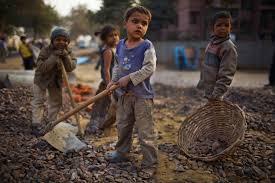
Today, close to 250 million children are working in the world. More than 150 million of these children are working in dangerous conditions. Additionally, each year more than 1 million of these children will be victims of human trafficking.
Definition of child labor
Child labor refers to any work or activity that deprives children of their childhood. In effect, these are activities that are detrimental to the physical and mental health of children and that hinder their proper development.
Child labor includes:
• Child labor before the minimum legal age : The basic minimum legal age at which children are authorized to work is 15 years (14 in developing countries). For light work (only a few hours from time to time) the limit is fixed at 13 to 15 years (12-14 in developing countries). Finally, for hazardous work, the limit is pushed up to 18 years (16 years under certain conditions in developing countries).
• The worst forms of child labor: This encompasses all forms of slavery or similar practices such as forced labor, trafficking, debt bondage, serfdom. It also includes illicit activities and/or activities likely to endanger the safety, health, and morals of children, such as prostitution, pornography, forced or compulsory recruitment for armed conflict, drug trafficking, etc.
• Hazardous work : This encompasses domestic tasks carried out over long hours in an unhealthy environment, in dangerous places requiring the use of dangerous tools or materials, or forcing the child to carry objects that are too heavy.
Certain activities are not considered labor or exploitation. Activities which simply involve helping parents to complete everyday family chores, to which children can dedicate a few hours a week and which permit them to earn some pocket money, are not considered child exploitation because they do not hinder their well-being.
Negative effects of child labor
The difficulty of tasks and harsh working conditions create a number of problems such as premature ageing, malnutrition, depression, drug dependency etc.
From disadvantaged backgrounds, minority groups, or abducted from their families, these children have no protection. Their employers do whatever necessary to make them completely invisible and are thus able to exercise an absolute control over them. These children work in degrading conditions, undermining all the principles and fundamental rights based in human nature.
Additionally, a child who works will not be able to have a normal education and will be doomed to become an illiterate adult, having no possibility to grow in his or her professional and social life.
In certain cases, child labor also endangers a child’s dignity and morals, especially when sexual exploitation is involved, such as prostitution and child pornography.
Furthermore, a child who works will be more exposed to malnutrition. These children are often victims of physical, mental, and sexual violence.
Overview of child labor in the world
Child exploitation exists on all continents and takes various forms according to the traditions and cultures of the region.
• In South East Asia and in Pacific, girls are sold to supply prostitution networks or to work as domestic workers. Many children are also sold to work in textile factories as well as to cover family debts.
• In Africa, parents sell their children, often for livestock (generally, the child will be sold for a cow). These children are exploited in plantations, mines, or will become domestic workers.
• In North America and in Latin America, children are victims of prostitution to satisfy the perverse appetite of tourists, and are exploited more and more by drug traffickers.
Source: Humanium
 FR
FR EN
EN AR
AR








